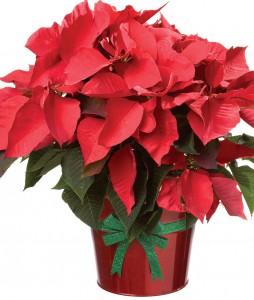Aztec floral gift allows US florists to ‘jingle-all-the-way’ to their banks
 In Pat Mora’s and Charles Ramírez Berg’s cuento, The Legend of the Poinsettia, their hero, little Carlos, fears attending the last event of his Mexican pueblo’s annual Posadas. Why? Because he has nothing to offer Baby Jesus on his birthday, which will be celebrated at the town’s parish.
In Pat Mora’s and Charles Ramírez Berg’s cuento, The Legend of the Poinsettia, their hero, little Carlos, fears attending the last event of his Mexican pueblo’s annual Posadas. Why? Because he has nothing to offer Baby Jesus on his birthday, which will be celebrated at the town’s parish.
In case you’ve never heard of this timely tale nor know beans about the Aztecs and their cuetlaxochitls, here’s our Christmas present to you.
Around the 14 through 16th centuries, these beautiful plants’ sap was utilized to control fevers, while their leaves produced a reddish dye. The last of the Aztec royalty, Moctezuma, enjoyed their beauty so much, that he had them brought into what is now Mexico City from the low-lands. The Aztec city, the oldest capitol in the Americas, and located 7,200 feet above sea level, was not conducive to growing such delicate flowers.
Things didn’t go Mocte’s way, history tells us, but one of his favorite flowers became the center of interest for one Juan Balme, a 17th century Spanish botanist. So much in fact, that Sr. Balme noted the plant in his scientific writings and soon thereafter, another botanist, Karl Ludwig Wilenow, christened it Euphorbia Pulcherrima, which allegedly means “very beautiful.”
According to botany wisdom, Herr Wilenow was “dazzled by the plant’s flowers, which begin to sprout one day through a crack in one of his greenhouses.”
Enter the ever-entrepreneurial American Anglos. During the John Quincy Adams administration, one Joel Roberts Poinsett, was appointed as U.S. Minister to Mexico. At that time these “ministers” served as ambassadors and although his résumé did not state it, he was known as an official “Indian hater.” In Mexico, while a civil war raged around him, his botanical know-how led him to introduce the American Elm into Mexican horticulture. His interest in the science of plants eventually had him wandering about Mexico’s lush countryside. Sometime in 1828, Poinsett came across an interesting shrub with large red flowers growing wild next to a muddy country road. Immediately he took some cuttings of the plant and after being kicked out of Mexico, upon his return his beloved South, replanted the cuetlaxochitl in one of his South Carolina greenhouses.
During the last years of his life, Poinsett, who had been recalled as minister, continued to work the flower throughout the South as a symbol of Christmas, and succeeded in making a small fortune. (This same story, of an American stumbling on something Mexican and turning such a product or idea into wealth, as we know, is not uncommon.)
The late, great and good amigo/colega, José Antonio Burciaga wrote in his book, Drink Cultura, that because Poinsett meddled so much in the affairs of Mexico and the rest of Latin America, t the term “poinsettismo” was coined to describe officious and intrusive conduct. When he took sides in a political dispute, Poinsett was finally declared person non grata by the infuriated Mexican government.
Perhaps the “official” name, having come from Germany or the fact that it was steeped in early Mexican folklore, caused the flower to be re-named after the racist minister. What actually happened – quien sabe? But historian and horticulturist, William Prescott, who had just penned, Conquest of Mexico, “honored” the minister by naming Moctezuma’s cuetlaxochitl, “poinsettias.”
In due time, the Mexican flower grew in popularity, becoming the legitimate and official Christmas flower. Ironically, in Mexico, long before anybody gave it a second look, the flowers became known as Nochebuenas, in honor of that famous silent night Baby Jesus came into this world.
Next came the California connection. Some 25 miles north of San Diego, along the beautiful Pacific Coast Highway (PCH) a.k.a. Highway One, lies Encinitas, once recognized as “the flower capital of the world.” The beachtown that attracts more than its share of surfers, is also where the renowned Ecke Poinsettia was introduced in 1923. (Poinsettias grow rapidly in southern California and the innocent holiday bouquet planted in a yard can take off unexpectedly and may become a tree, claim nurseries.)
The Ecke Ranch poinsettias and others have become part of the American Christmas traditions. Then too, say flower retail experts, total U.S. poinsettia sales produce more than $300 million for growers, nurseries and florists during the holidays. To say that the land that gave the world one of its most cherished Christmas customs is envious, would be an underestimation.
Mexico, you see, until this year, couldn’t sell the plants in the United States because of restrictions on importing Mexican soil.
And to all, a muy Feliz Navidad!





